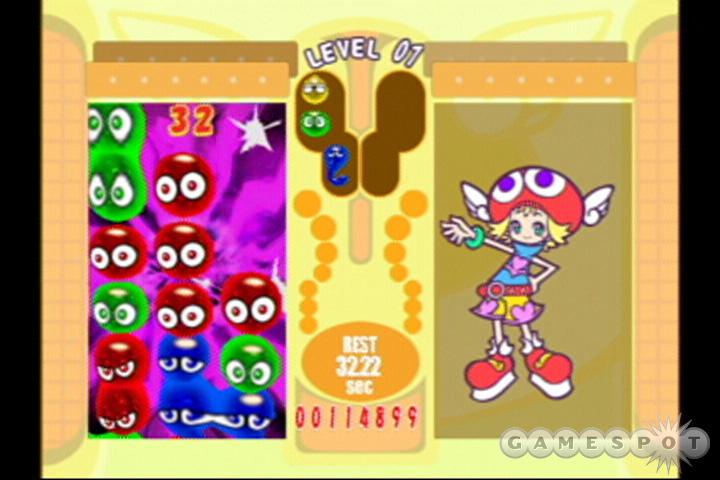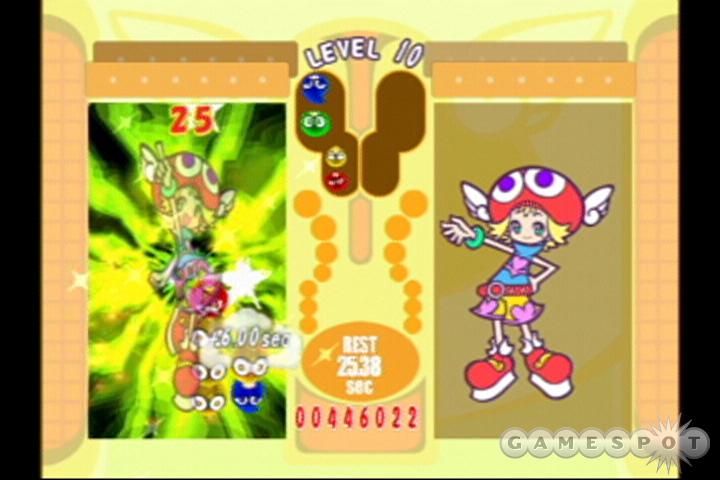Sega has been releasing Puyo Pop games in some form or another on various platforms for the better part of a decade now. Originally appearing in the US under the guise of Dr. Robotnik's Mean Bean Machine, the series has carved itself a modest niche in the fairly sleepy genre of puzzle games, and the fan base, while small, is quite dedicated. Puyo Pop Fever, which has just arrived on the GameCube, comes with a new coat of paint and a new gameplay mechanic, but at its core, it's still the same old Puyo Pop. If this is your first time with a Puyo Pop game, then this really isn't a bad thing, as the gameplay still stands up after all these years.
If you've played virtually any puzzle game from Tetris on forward, Puyo Pop Fever's vertically oriented playing field and color-coded pieces should seem nice and familiar. The gameplay concept is nothing radical--coupled sets of what appear to be gumdrops with eyes fall down the playfield, and your goal is to orient them in order to set up chains of four like-colored gumdrops.

Unlike many puzzle games, though, Puyo Pop Fever is mostly about competitive play, and whether you're playing against the computer or a friend, your real goal is to fill up their side of the field with colorless junk gumdrops. The best way to fill up your opponent's field quickly is by creating chain combos, where clearing one set of gumdrops causes another set of gumdrops to clear, and so on. This is where the hidden depth in Puyo Pop really comes to light, and it's also the basis for Puyo Pop Fever's new gameplay addition, the fever mode. When you trigger fever mode, you're presented with a preconfigured field and a pair of pieces that, when placed correctly, are capable of creating massive chain combos. The fever mode runs at a much faster pace than the regular Puyo Pop game, which Puyo purists may find jarring, but it generally serves as a nice addition to the core gameplay.
Puyo Pop Fever puts a cheery, colorful wrapper around the gameplay, complete with a single-player story mode set in a Harry Potter-turned-anime sort of universe, pitting you against a series of bizarrely cute characters. This mode, while not particularly long, does offer a pretty significant level of challenge. If you're playing solo, there are also three different "endless" modes, which will go on as long as you can keep your well under control. These include a traditional Puyo Pop game, a mission mode that presents you with a series of specific tasks that you must complete, and another fever mode, which has you constantly trying to clear the entire screen with one or two pieces. There are also several two-player options, which let you play either with or without the fever gameplay, and you can also edit the rules to tweak things to your specific liking. The gameplay options are mostly sufficient, though it's disappointing that the multiplayer action is limited to two-player, especially when you consider that Puyo Pop for the Game Boy Advance, which was released two years ago, featured four-player competitive play.
Sonic Team has maintained a laserlike focus on giving its games an intensely cute, cheery look, and Puyo Pop Fever does not break this trend. Though it isn't much of a technical powerhouse on the GameCube, there's a nice unified look to the game, and everything runs smoothly. There are plenty of big colored particle effects whenever you clear some pieces, and the background gets downright psychedelic when you enter the fever mode. There are some other nice, smaller touches that help bring everything together, such as the different looks that the different colored gumdrops have, which gives each color a sort of unique bit of personality.

Bright, primary colors definitely work to the advantage of a game where the gameplay itself depends on different colors; however, the game's cheery sound design ends up coming across as screechy and annoying. The music, which could be charitably described as techno for kids, is layered over with the high-pitched voices of the characters, who will chime in whenever anything of importance happens. If you have already built up a tolerance for the voice acting in anime kids' shows, you should be able to cope, but otherwise you'll probably just want to turn down the volume.
For a puzzle game to have real longevity, it needs to be able to successfully marry the two rather disparate concepts of a basic, easy-to-learn gameplay concept and significant strategic depth. Puyo Pop has had this from the beginning, and Puyo Pop Fever maintains this tradition. The new Fever gameplay helps pick up the pace, though its impact on the overall feel of the game isn't particularly radical. If you can tolerate the game's forcibly cute presentation, you'll find Puyo Pop Fever to be a solid, addictive puzzle game.



